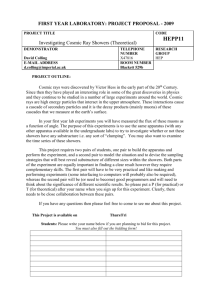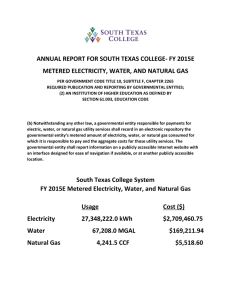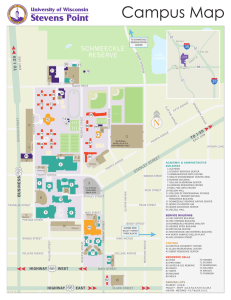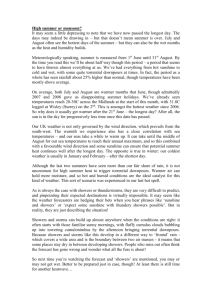TechTips Engineering Operations WATER CONSERVATION PLUMBING FIXTURES:
advertisement
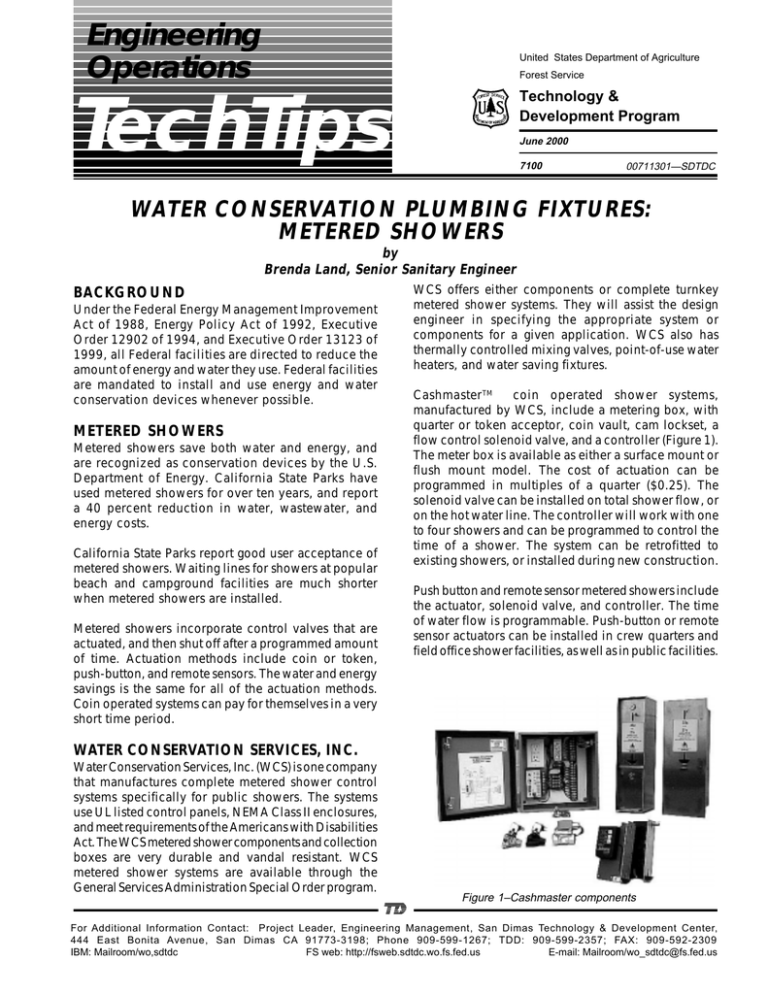
Engineering Operations United States Department of Agriculture Forest Service Technology & Development Program TechTips June 2000 7100 00711301—SDTDC WATER CONSERVATION PLUMBING FIXTURES: METERED SHOWERS by Brenda Land, Senior Sanitary Engineer BACKGROUND Under the Federal Energy Management Improvement Act of 1988, Energy Policy Act of 1992, Executive Order 12902 of 1994, and Executive Order 13123 of 1999, all Federal facilities are directed to reduce the amount of energy and water they use. Federal facilities are mandated to install and use energy and water conservation devices whenever possible. METERED SHOWERS Metered showers save both water and energy, and are recognized as conservation devices by the U.S. Department of Energy. California State Parks have used metered showers for over ten years, and report a 40 percent reduction in water, wastewater, and energy costs. California State Parks report good user acceptance of metered showers. Waiting lines for showers at popular beach and campground facilities are much shorter when metered showers are installed. Metered showers incorporate control valves that are actuated, and then shut off after a programmed amount of time. Actuation methods include coin or token, push-button, and remote sensors. The water and energy savings is the same for all of the actuation methods. Coin operated systems can pay for themselves in a very short time period. WCS offers either components or complete turnkey metered shower systems. They will assist the design engineer in specifying the appropriate system or components for a given application. WCS also has thermally controlled mixing valves, point-of-use water heaters, and water saving fixtures. coin operated shower systems, Cashmaster TM manufactured by WCS, include a metering box, with quarter or token acceptor, coin vault, cam lockset, a flow control solenoid valve, and a controller (Figure 1). The meter box is available as either a surface mount or flush mount model. The cost of actuation can be programmed in multiples of a quarter ($0.25). The solenoid valve can be installed on total shower flow, or on the hot water line. The controller will work with one to four showers and can be programmed to control the time of a shower. The system can be retrofitted to existing showers, or installed during new construction. Push button and remote sensor metered showers include the actuator, solenoid valve, and controller. The time of water flow is programmable. Push-button or remote sensor actuators can be installed in crew quarters and field office shower facilities, as well as in public facilities. WATER CONSERVATION SERVICES, INC. Water Conservation Services, Inc. (WCS) is one company that manufactures complete metered shower control systems specifically for public showers. The systems use UL listed control panels, NEMA Class II enclosures, and meet requirements of the Americans with Disabilities Act. The WCS metered shower components and collection boxes are very durable and vandal resistant. WCS metered shower systems are available through the General Services Administration Special Order program. Figure 1–Cashmaster components For Additional Information Contact: Project Leader, Engineering Management, San Dimas Technology & Development Center, 444 East Bonita Avenue, San Dimas CA 91773-3198; Phone 909-599-1267; TDD: 909-599-2357; FAX: 909-592-2309 IBM: Mailroom/wo,sdtdc FS web: http://fsweb.sdtdc.wo.fs.fed.us E-mail: Mailroom/wo_sdtdc@fs.fed.us For additional information contact WCS: WWW.WATERCON.COM Water Conservation Services, Inc. 4612 Via Robla, Santa Barbara, CA 93110 E-Mail info@watercon.com Phone (805) 692-9949 FAX (805) 692-9907 Metered Showers are also available from; but are not currently UL listed. Fluid Manufacturing, Inc. 100 E. Lodi Ave. Lodi, CA (800) 443-5843 Trumbull Recreation Supply P.O.Box 109 Willington, CT 06276 Shower-trol Metered Showers About the Author… Brenda Land graduated from the Oregon Institute of Technology with a Bachelor of Science degree in Civil Engineering Technology. She began her career on the Gifford Pinchot National Forest doing road construction inspection and facilities construction inspection. Brenda transferred to the Allegheny NF as a Facilities Engineer, designing developed recreation areas. Brenda came to San Dimas Technology and Development Center in 1994 to find solutions to human waste, wastewater, and potable water problems on National Forest lands. Library Card Land, Brenda, ed. 2000. Water conservation plumbing fixtures: metered showers. Tech Tip 0023-1301SDTDC. San Dimas, CA: U.S. Department of Agriculture, Forest Service, San Dimas Technology and Development Center. 4 p. Presents information on metered shower facilities that can reduce the amount of energy and water consumed. Federal facilities are mandated to install and use energy and water conservation devices whenever possible. Names and addresses of vendors are provided. The Forest Service, U.S. Department of Agriculture has developed this information for the guidance of its employees, its contractors, and its cooperating Federal and State agencies, and is not responsible for the interpretation or use of this information by anyone except its own Keywords: water conservation, metered showers, plumbing Additional single copies of this document may be ordered from: USDA Forest Service San Dimas Technology and Development Center ATTN: Richard Martinez 444 E. Bonita Avenue San Dimas, CA 91773 Phone: (909) 599-1267 x201 Fax: (909) 592-2309 E-mail: rmartinez/wo_sdtdc@fs.fed.us FSNotes: Richard Martinez/WO/USDAFS For additional technical information, contact Brenda Land at the address above. Phone: (909) 599-1267 x219 Fax: (909) 592-2309 E-mail: bland/wo_sdtdc@fs.fed.us FSNotes: Brenda L Land/WO/USDAFS Internet: bland@fs.fed.us An electronic copy of this document is available on the Forest Service’s FSWeb Intranet at: http://fsweb,sdtdc.wo.fs.fed.us employees. The use of trade, firm, or corporation names in this publication is for the information and convenience of the reader and does not constitute an endorsement by the U.S. Department of Agriculture of any product or service to the exclusion of others that may be suitable.

